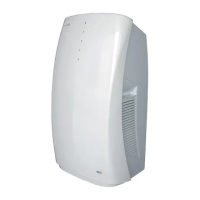
Do you have a question about the Argo MAGICO 9.2 AMG26MIR and is the answer not in the manual?
| Brand | Argo |
|---|---|
| Model | MAGICO 9.2 AMG26MIR |
| Category | Air Conditioner |
| Language | English |
Details about the unit's performance, electrical ratings, features, dimensions, weight, and operating limits.
Details of major components like Controller PCB, Thermistors, Fan Motor, Compressor, Pump relay, and Heat Exchanger coils.
Provides a visual representation and measurements (height, width, depth) of the air conditioner unit.
Detailed wiring diagram showing component connections and color codes for electrical troubleshooting.
Illustrates the path of the refrigerant through the air conditioning system.
Explains how the compressor and fan operate in cool mode based on temperature differences.
Describes the unit's operation in dehumidification mode, focusing on humidity control and mild cooling.
Details how the fan operates to circulate air in the room without compressor activation.
Explains evaporate coil defrost protection mechanisms to prevent ice formation during low ambient temperatures.
Describes how room temperature is automatically adjusted for comfort during sleep in cool mode.
Explains how the unit can be programmed for automatic ON/OFF operation at set times.
Details the I-Feel function, where the remote controller's sensor measures room temperature for better control.
Describes the operation of push buttons and LED indicators for manual unit control without a remote.
Explains how unit settings are saved and automatically restored after a power interruption.
Presents a chart showing operating current versus room temperature with relative humidity around 50%.
General guidelines and warnings for performing troubleshooting procedures safely.
Troubleshooting steps for when the air conditioner fails to start, including circuit breaker and fuse checks.
Guides for diagnosing issues where only the fan or only the compressor motor is not running.
Troubleshooting steps for operational issues like remote control malfunctions and PCB defects.
Steps to diagnose and resolve poor cooling performance, including checking settings and refrigerant levels.
Guidance on addressing situations where the unit provides too much cooling.
Identifies symptoms of a defective sensor (TH1/TH2) and how to address it.
Detailed instructions for measuring insulation resistance, checking fuse continuity, and testing motor capacitors.